B532
Management of Lambs and Kids -
Saving and Rearing Newborns
reviving chilled newborns | reviving
starving newborns | helping mothers own their
newborns | cross-fostering (grafting) | lamb
coats | rearing orphans or newborns
Introduction:
Good management and
proper training can improve the lambing/kidding crop by 5%, and even up to 10%
in flocks/herds where losses are generally high. The producer should focus on
the following five areas, and every effort to enhance one’s skills in these
areas should be made.
- Reviving chilled newborns
- Reviving starving newborns
- Helping mothers own their newborns
- Cross-fostering
- Rearing orphans and newborns removed from the mother
- Reviving Chilled Newborns: Newborns are subjected to an extreme
temperature change, even if they are born in moderate weather. They have
just spent nearly 5 months inside their dams at a temperature of 102° F,
then they are suddenly dropped into the
outside environment that may be 100 degrees cooler. This sudden change may be
one of the most significant causes of death in very young newborns. It is
estimated that greater than 10% of the lambs born alive never live to weaning
age and that about 3/4ths
of these die during the first week. Artificial warmth for the newborn will, in
many cases, improve these statistics.
Chilled newborns are often well on the way to death when found. They are
usually only a few hours old and were probably born on a night that was cold,
windy, or wet. These newborns may or may not have had a suckle of colostrum
milk (first milk). A quick and easy way of determining a cold newborn is by
placing a finger in the mouth. A cold mouth and a lack of a suckling reflex
can be a great indicator of a serious problem.
First, put the newborn in a warm place in a barn, shelter, vehicle, camp, or
house. If possible, catch the mother or identify her with a dye pistol (a
squirt gun with human hair dye), chalk, or paint mark for later
identification. When there are several newborns to deal with, also identify
the lamb/kid with spray paint, chalk, or crayon.
One of the best ways of warming a newborn is to surround it with warm water
bottles wrapped inside an old blanket, old burlap wool sacks, or similar
materials. Infrared heat lamps, blow dryers, or just putting the lamb/kid
wrapped up in front of a wood fire or stove will also work. Usually, when the
newborn has revived it will become more active, show more alertness, make
sounds, and begin moving around looking for milk. Caution should be used when
any artificial or electric sources of heat are applied to warm the newborn.
These sources of heat have a significant chance of burning the lamb/kid.
Regularly test the surface temperature of the newborn with an exposed hand. If
it feels too hot, it probably is hot enough to injure the newborn.
Using Heat Lamps: One way of providing artificial heat to young newborns
is to use an infrared, 250-watt lamp, suspended about 3.5 to 4 feet over the
lambing/kidding pens or jugs. The mother and her newborn(s) should be confined
in these pens for several days, depending on the strength and vigor of the
babies. When using heat lamps, here are some important points to keep in mind:
- Although this bulb has a built-in-reflector, it is best to shield it
with a metal reflector to prevent moisture dropping on it while hot.
- Be sure to fasten it securely so that it cannot fall on the bedding.
- Do not hang it within 18" of the mother’s back or it will burn
the wool or hair.
* When the newborn revives, get it nursing from its mother as soon as
possible.
Reviving Starving Newborns: If the weather is mild, mismothered or
abandoned newborns may wander around for days, gradually losing their internal
fat reserves before they die. Others may simply be too weak to consume
adequate amounts of milk. The skilled producer can identify these newborns by
their hollow-sided, gaunt, tucked-up look. The earlier they can be identified,
the better the chance of saving them. Starving newborns may not necessarily
need warming, but will need milk immediately. Lambs and kids that are less
than 24 hours old will require colostrum. In addition, some should be given
dextrose solution (or glucose), combined with amino acids and electrolytes (Biolyte).
Giving Colostrum: Give a minimum of 150 mLs (5 oz) of natural colostrum as
soon as possible. This amount should be given at least 2 more times in the
first 24 hours of life. See page B520 for additional information on feeding
colostrum.
Helping Mothers Own Their Newborns: Persuading a ewe/doe to claim
her newborn(s) can sometimes be very difficult. The problem is greater for new
mothers that are giving birth for the first time. If a ewe/doe does not mother
well 2 years in a row, she probably should be culled.
Why does a ewe/doe fail to claim her offspring? There is no clear cut answer
to this question. She may disown one or all of her newborns for a variety of
reasons:
- A ewe/doe may deliver one baby in one part of the barn and a second
baby in another part of the barn.
- The newborn may wander away from the mother before she has fully
recovered from delivery.
- The ewe/doe may have a very painful udder because of swelling,
caking, or infection.
- The teats may be cut or chapped, causing the ewe/doe a great deal of
discomfort.
- A ewe/doe that has been in labor for a long-time may not be
interested in her newborn for quite a while after delivery.
- Sometimes a ewe/doe may run a high temperature for several days after
lambing/kidding and not show much interest in her newborn(s).
- Sometimes ewes/does that are very nervous and flighty may present
problems.
- Some young ewes/does giving birth for the first time may be
frightened by the newborn(s).
It takes a lot of patience to work effectively with a ewe/doe that
disowns her newborn. Keep in mind that it is much easier for the ewe/doe
to raise her newborn than for the producer to raise an orphan. Many
ewes/does separated from their own newborns will take them back without
trouble. Others, especially maiden mothers (yearlings or first time
mothers), are often reluctant to take them back and may need firm
encouragement for 12-24 hours (or more) before they will. One reliable
method is to tie the ewe/doe to the side of a pen with twine so that the
lamb/kid can suckle without being kicked or butted. Other methods of
grafting back a lamb/kid to its birth dam are available, and all have
varying levels of success (see below).
Cross-fostering (grafting): All producers are faced at some stage
with orphaned animals or with mothers unable to feed them because of mastitis
or damaged teats (i.e. shearing cuts). If a suitable ewe/doe is available,
fostering is the easiest option in the long run.
Various means can be tried to encourage the foster mother to accept the
newborn. A traditional method is to attach the skin of the mother’s own dead
baby on the orphan until the new mother accepts it. The use of lamb coats is
an alternative to skinning a dead newborn. The mother’s sense of smell can
also be overpowered or confused by smearing a strong smelling substance such
as aniseed, various aerosol type products, or even the mother’s own milk on
the newborn around its nose, face, tail and dock areas. The same substance
should also be placed on the mother’s muzzle. A few special commercial
products are also available for this purpose (U-Lamb or Mother-Up).
Confine the mother and newborn in a restricted area with food and water until
the relationship is firmly established. Hold the ewe/doe several times a day
to ensure that the lamb/kid has a suckle, or tie her head up in such a way
that she cannot butt or repel the newborn, but still reach her food and water.
Lamb Coats: The traditional method of skinning a dead newborn and placing
the skin over an orphaned newborn’s body maybe unappealing to some
producers, or a dead newborn may not be available to use for the skin. To help
overcome this problem, two products have been introduced to the U.S. market.
These products are Fostercoat™ and Lamb Woolover™.
- Fostercoat: Fostercoat may be
cut to any length required. The diagram shows suggested position and length of
slits for legs and anal-genital area. Openings for umbilicus (navel) and the
male genitals (sheath) are made after Fostercoat is fitted on the newborn.
Fostercoat has a unique knitted 100% polyester pile construction capable of
absorbing body odor when worn for a time by the natural offspring. The uses
for Fostercoat include substitution fostering, add-on fostering, assisting in
retaining body temperature, and for weather protection. After use, Fostercoats
should be discarded or washed prior to re-use.
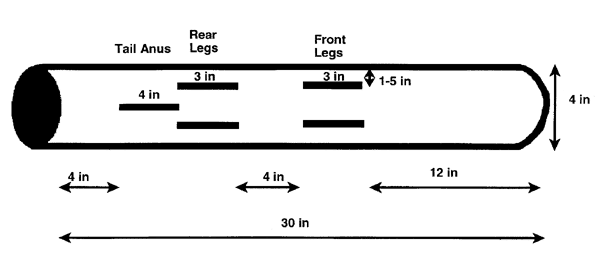
- Substitution fostering: Substitution fostering is most successful
when started as soon as possible after the birth of a stillborn (dead)
lamb/kid. To substitute an orphaned lamb/kid for a stillborn, pull the
dead lamb/kid through the Fostercoat several times. This process transfers
the birth fluids from the dead newborn to the Fostercoat. The newborn to
be fostered is then fitted with the Fostercoat turned inside out and
introduced to the foster mother. It is advisable to tape or tie the
newborn’s legs for approximately 15 minutes to prevent it from sucking
and to allow the ewe/doe to become familiar with the foster baby.
Fostercoats may be removed from adopted animals 48 hours (2 days) after
acceptance occurs.
- Add-on fostering: To add on an "extra newborn" to the
ewe/doe who has only a single newborn but enough milk to raise twins,
Fostercoat is fitted on both the natural lamb/kid and the lamb/kid to be
fostered. After a few hours, the body odors are absorbed by the
Fostercoats. The Fostercoats are turned inside out and then exchanged
between the two newborns. The newborn to be fostered is then placed with
the foster mother and her natural baby. Because add-on fostering is more
difficult than substitution fostering, it is helpful to exchange
Fostercoats several times to confuse the mother as to which newborn is her
own.
- Lamb Woolover: The Lamb Woolover is a coat that also provides
multiple uses for the producer. The Woolover coat is made of 100% wool and can
be used for treating newborns with hypothermia, for grafting orphan newborns
to a foster dam, and for protection from sudden weather changes. The Lamb
Woolover is a durable product that can be re-used over and over again. It has
no fasteners (velcro or string ties) that could cause chafing to young
animals. Fitting for a newborn only takes seconds. The same company that makes
the Lamb Woolover also makes them for goat kids and baby calves.

- Fitting procedure:
- Roll the tail end of the cover forward. Grasp both front legs of
the newborn in one hand and guide them through the front holes. Pull
the cover up to the knees.
- Push the newborn’s head forward through the neck opening.
- Unroll the rear of cover and place each rear leg through the
holes.
* Each cover will offer beneficial protection and can be left on for
2-3 weeks. The covers will then only be suitable for recycling. To
obtain multiple uses of each cover, they should be removed (weather
permitting) after 3-4 days.
Rearing Orphans or Newborns Removed from the Mother:
- Choice of Feed:
Lambs -
If it is available,
ewe milk is the best option. A second choice would be goat milk, and a third
choice would be full cream cow milk. All of these should be fed after
the lamb has received colostrum. Lamb milk replacers can be used if other milk
is not available. Cow milk is lower in protein than ewe milk. This means that
when using calf milk replacer for lambs, it should be made up at a slightly
higher concentration than what the label may recommend. Do not water-down cow
milk – if anything, strengthen it with a small amount of milk replacer.
However, do not over concentrate the milk. Over concentrated cow milk can
cause constipation and death.
Kids - If it is available, doe milk is the best option. A second
choice would be ewe milk, and a third choice would be full cream cow milk. All
of these should be fed after the kid has received colostrum. Kid milk
replacers can be used if other milk is not available. The kid milk replacers
usually have about 20-28% protein and 18-25% fat (homogenized). Because ewe’s
milk is higher in fat and protein than doe’s milk, it should be slightly
diluted before feeding to kid goats.
When using natural milk from a ewe, goat, or cow, it is often heat treated to
prevent the spread of diseases like caprine encephalitis and Johnes
disease. This is particularly important when feeding goat’s milk to kids.
The following procedure can be used to heat treat milk (not colostrum): Using
a double boiler system, bring the desired amount of milk to 165° F and keep
it there for 15 seconds. Let the milk cool, and then feed it to the lamb/kid.
For colostrum heat treatment see B520.
How to Feed: If only a few newborns are to be reared, the standard
plastic pop bottle, fitted with an artificial teat can be used to hand feed
each newborn. This works well but is very demanding and time consuming. If
more than three or four newborns are to be reared, self-feeding "lamb
bars" may be made or purchased.
Lamb bars can handle up to about 30 lambs/kids and consists of a metal or pvc
plastic tank with ewe/doe size artificial teats attached. The "lamb
bar" can be shortened or only one side used if only a few lambs/kids are
to be reared. Both round and square lamb bar buckets, fitted with teats are
available from supply houses. All teats or nipples from artificial devices
should be at least 12-14 inches above the ground level. Provide one nipple for
every 2-3 lambs/kids. It is best to separate lambs/kids by age in groups of
10-20. Up to 30 lambs/kids per grouping can be fed, provided there is
sufficient space.
Each teat has a washer foot-valve inserted into its base to prevent leakage.
This can be inserted quite easily by holding the teat open with the pliers
normally used to expand elastrator rings (used for docking and castration).
Commercially, ready-made teats or nipples are also available for quick
attachment to lamb bar milk holding tanks. As an alternative, the teats can be
set into the tank above milk level, with suction tubes instead of valves. This
is quite satisfactory but the lambs/kids may be a little harder to start.
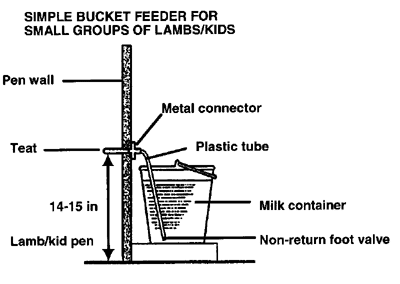
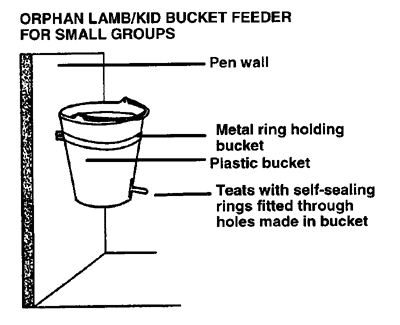
- Using the "Pritchard" teats in feeding orphans: New teats
(nipples) are supplied with no hole in the end and thus must be cut before
use. There are two different techniques to cut the teat. The common, older
technique is to use sharp scissors and snip off the end of the teat. This
means the more that is clipped off, the bigger the hole. Caution should be
used to avoid making the hole extremely large. Another technique is to
carefully make two slits in the end of the teat with scissors. The two
slits form a ‘+’ or ‘x’ that snaps back together when not in use,
creating a type of "self-seal." Most important, this
self-sealing method of cutting the teat allows the bottle of milk to be
left in an inverted position. This allows the lambs/kids to suck at their
leisure without the loss of milk from the nipple. Many producers prefer
the Pritchard teats over the larger, old-fashioned teat models still on
the market.
|
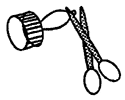
Old Method
|
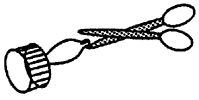
New Method
|
- The following list contains suggestions on proper sanitization and
maintenance of artificial teats:
- Be sure not to lose the tiny ball that rattles when teat is
shaken. If it is lost, the teat will leak. This happens rarely and
primarily only from washing the teats too aggressively.
- Do not leave teats sitting in the sunlight or overheated areas.
Especially do not leave them sitting on a window ledge or the
dashboard of a vehicle. Sunlight from this "greenhouse"
situation has been known to heat up the latex until it melts. Because
areas of high heat are bad for this type of latex, it is best not to
leave them close to an active stove or heater.
- Do not use them without the latex inner ring. This ring,
included free on "Pritchard" teats, enables an easy seal to
all bottles. If the teat is used without the latex ring, the teat will
make a very poor seal and will either leak or split.
- Do not clean the teats in boiling water. Use hot water with a
little dishwashing detergent and nothing more.
- Do not use Clorox to disinfect them. The strong chemical reacts
with the latex and can cause rapid disintegration.
- Do not use the teats beyond 2 or 3 years. Latex tends to become
sticky with use and prolonged exposure. Replacement is recommended
every year.
Bottles to Use: Pop bottles of
various sizes work fine. Now that the latex washer is included, the teats may be
used with plastic bottles as well as glass. Glass bottles disinfect better than
the plastic. For newborns, using a plastic maple syrup bottle (the kind with a
handle) works well. The shape allows the producer to squeeze the bottle as
needed. In doing so, the milk can actually be pushed into the lamb or kid’s
mouth. Because the bottle is clear, it is easy to see how much milk remains in
the container.
When to Feed and How Much: When
hand feeding, start with four, 5-8 oz feedings per day. Gradually build this up
to four, 16 oz feedings per day, depending on appetite. This should take about
2-3 weeks. Then go on to three, 24 oz feedings per day before weaning.
Milk may either be fed four times a day, or be made available to the lamb/kid at
all times ("ad lib" feeding). Milk that is fed four times a day is
often warm and fresh. Milk that is made available at all times should be chilled
(to prevent souring) before using to fill the lamb bar or continuous feeder. If
the weather is warm, it may help to insulate the tank on the lamb bar.
Lambs/kids fed continuously soon get used to chilled milk. Studies show that the
best growth rates have been achieved with this method. The lambs/kids take a
little milk every hour or so, just like they normally would from their mothers.
These animals soon learn to regulate their intake. Because many lambs/kids die
from eating too much, feed small amounts more frequently. Overfeeding can also
bring about serious scouring conditions in artificially reared lambs/kids of any
age. All equipment (bottles, teats, tanks) must be thoroughly cleaned each day
to prevent the spread of intestinal infections. Chlorhexidine and bleach are
commonly used.
Weaning Off of Milk and General Management: Weaning
often occurs at 8-12 weeks; well-grown newborns can be weaned after 4 or 5 weeks
of feeding milk. A producer may also decide to wean the newborn once it has
reached a "benchmark" weight of 2.5 times its birth weight. To help
develop the rumen, be sure to have the lamb/kid on an appropriate creep feed
prior to weaning time. Weaning should be abrupt, and it is best to get the
lambs/kids on a dry starter like alfalfa pellets or grain mix, instead of
straight onto lush pasture. These weaned lambs/kids can be placed on pasture
after 7-14 days on dry starter. Good quality hays (preferably legumes, i.e.
alfalfa, clover, pea, peanut, or vetch) or silage may also be used. Lambs/kids
being fed harvested roughages like hay or silage should also have access to
grain or grain mixes. All lambs/kids should have free access to clean, fresh
water and a coarse ground, trace mineral salt at all times. Additional weaning
diet information can be found on B580.





